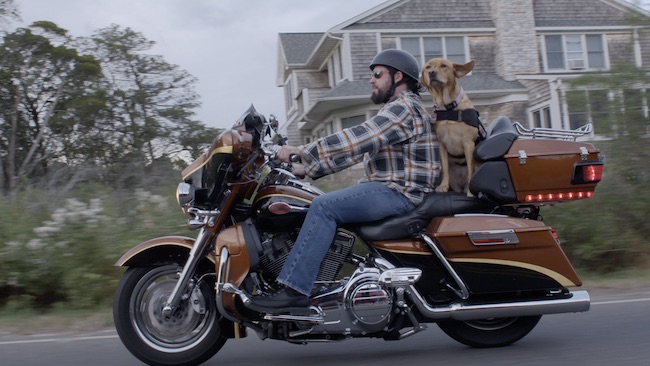By David-Elijah Nahmod
Josh Aronson’s new documentary To Be of Service, now available on DVD and also streaming at Amazon Prime and Netflix, paints vivid portraits of the physical and emotional scars combat veterans often live with after service.
To Be of Service Review
As the film opens, we meet a number of veterans of the Iraq and Afghanistan wars. Their stories are harrowing. One man recounts his experience of surviving a helicopter crash that claimed his leg; he describes how his limb was on fire while he screamed for help. A woman speaks of watching people die horrible deaths on the streets of Baghdad. Naturally, such experiences haunt these soldiers after they return home.
All of the documentary subjects have been diagnosed with PTSD — post traumatic stress disorder. Symptoms include severe depression, anxieties, nightmares and flashbacks to the horrific events which caused their conditions. At times, the symptoms are so severe they struggle to do day-to-day tasks.
One combat veteran admits to having attempted suicide — he lay in a coma for 19 days after filling his body with alcohol and pills. Another manages to take his daughter to school each morning, yet he is careful to stand far apart from the other parents because his deep paranoia has made it all but impossible for him to approach other people.
These are men and women who have been wounded on many levels and now live with a permanent disability. And as such, their doctors recommend that they get emotional support animals to help them manage some of their PTSD symptoms.
Service Dogs Helping Veterans
Aronson’s camera follows the veterans as they become acquainted with their new canine companions. There’s a training period, but it’s not just the dogs who are trained. While the dogs are taught how to obey commands and provide the needed emotional support, so are the humans. The veterans are taught how to interact with their new companions by a dog trainer. Each former military person establishes a deep bond with their dog, and the dog, filled with love and eager to please, bonds just as deeply to their humans.
The changes these animals make in their humans’ lives are remarkable. Thomas, the dad who was afraid to approach the other parents at his daughter’s school, now stands with the parents and happily waves goodbye to his little girl, his canine friend by his side. Greg, the man who attempted suicide and who found it difficult to leave his house to do the things he loves to do, now walks out his front door for a break to the beach a few blocks away.
PTSD: An Invisible Disability
Aronson spends a lot of time with his documentary subjects. The viewers get to know not only them, but also their family members. We see the depth of their pain, and we also see the joy in their faces as they transition into a more positive phase in life. They will always have PTSD, but now they have a canine companion that makes things easier. It’s a touching thing to see.
PTSD is an invisible disability, one that is not always taken seriously by the general public. To Be of Service puts a face on the condition, as well as explains symptoms and shows how it affects people. The film is a call for compassion and understanding. While the film has some scenes that tug at one’s heartstrings, it is ultimately an uplifting experience. Aronson wisely includes commentary from several psychiatrists, giving the film’s stories a great deal of credibility.
The film’s DVD includes optional closed captioning for the hearing impaired, but descriptive audio for the blind is nowhere to be found. The same goes for versions on Amazon Prime and Netflix. For a documentary that deals with disability, this is a glaring omission on the part of the production and distributor.
Buy To Be of Service on Amazon now!
Note: Some of the links in this post are affiliate links and I will earn a commission if you purchase through these links (at no additional cost to you).
Photo: Courtesy of To Be of Service


